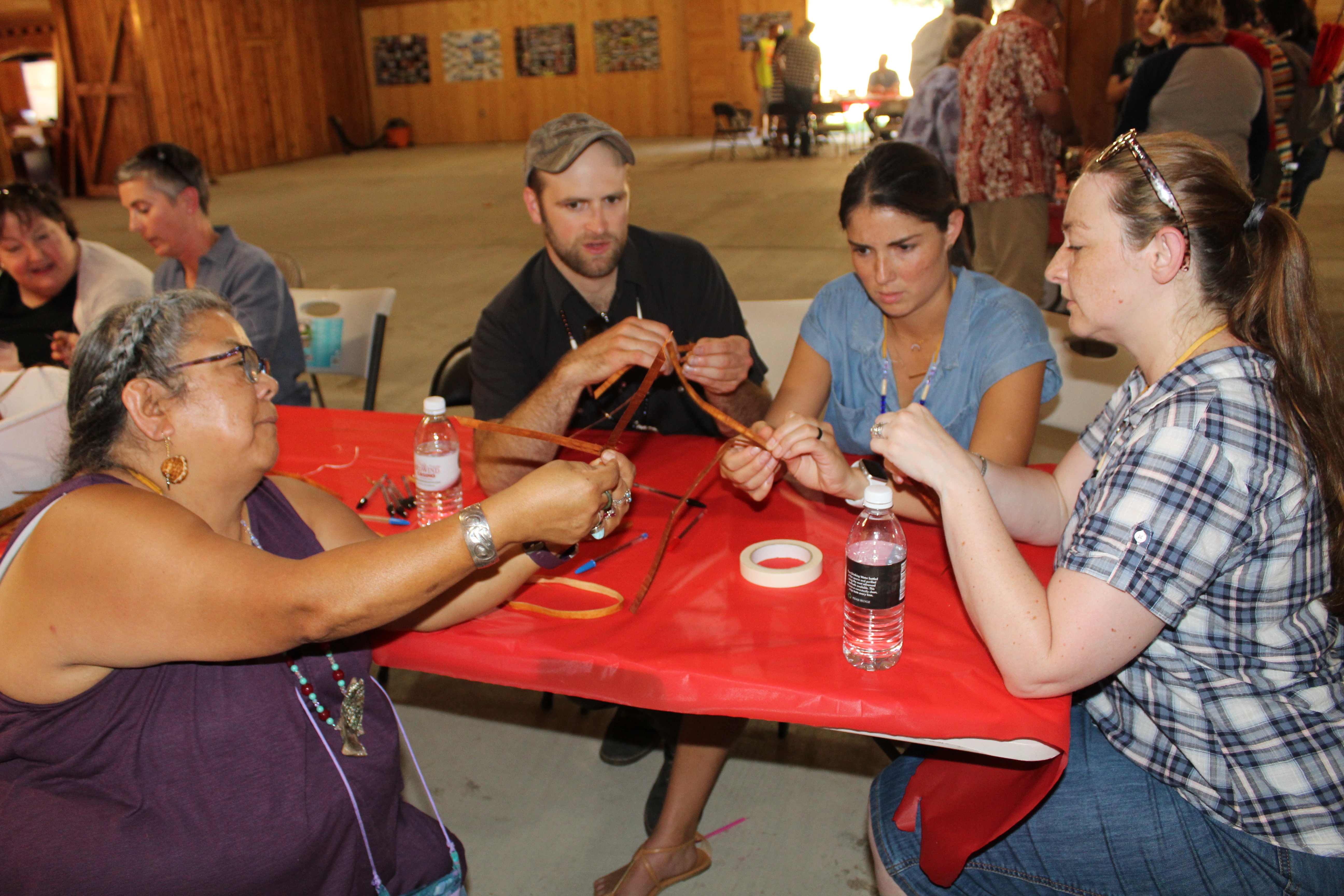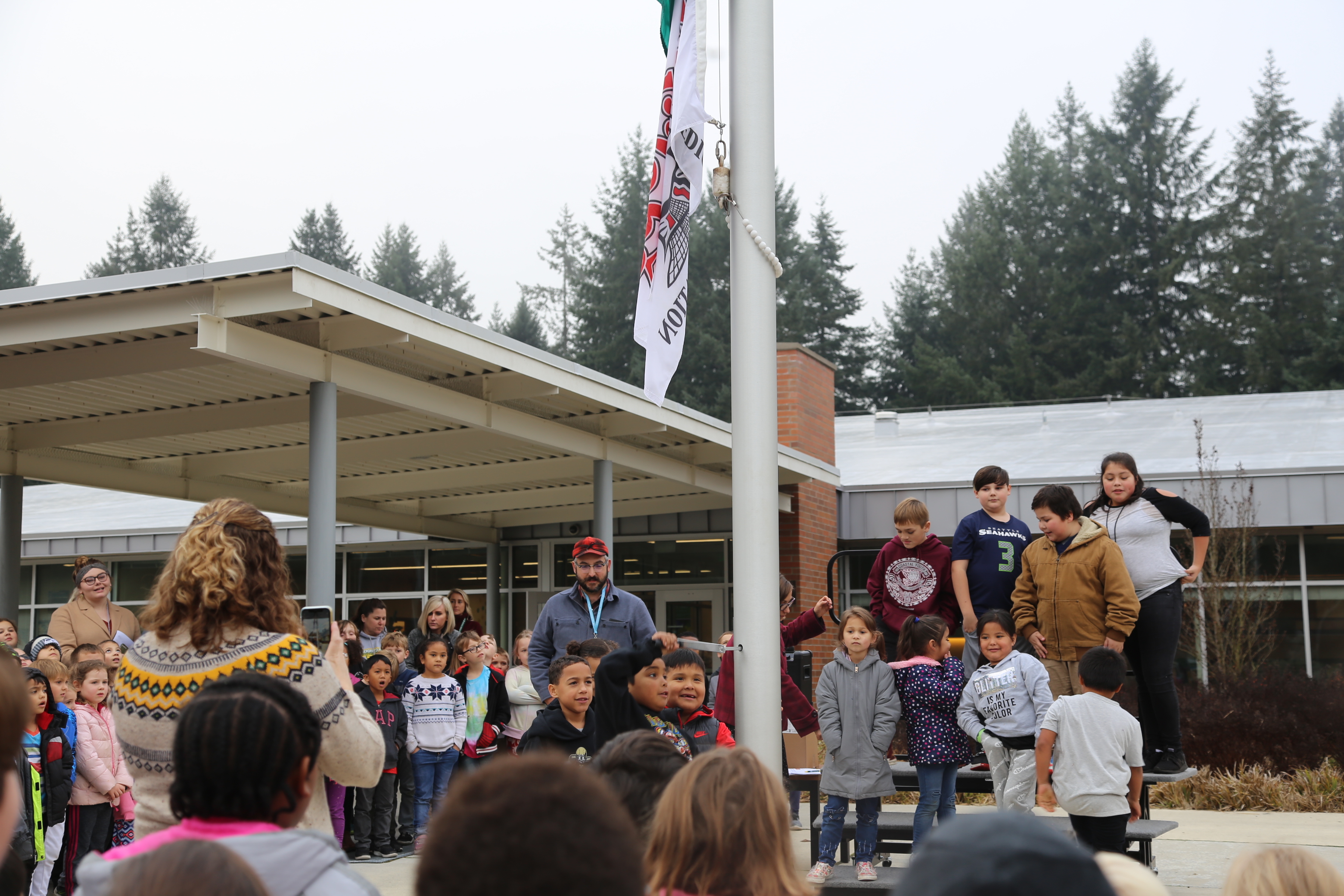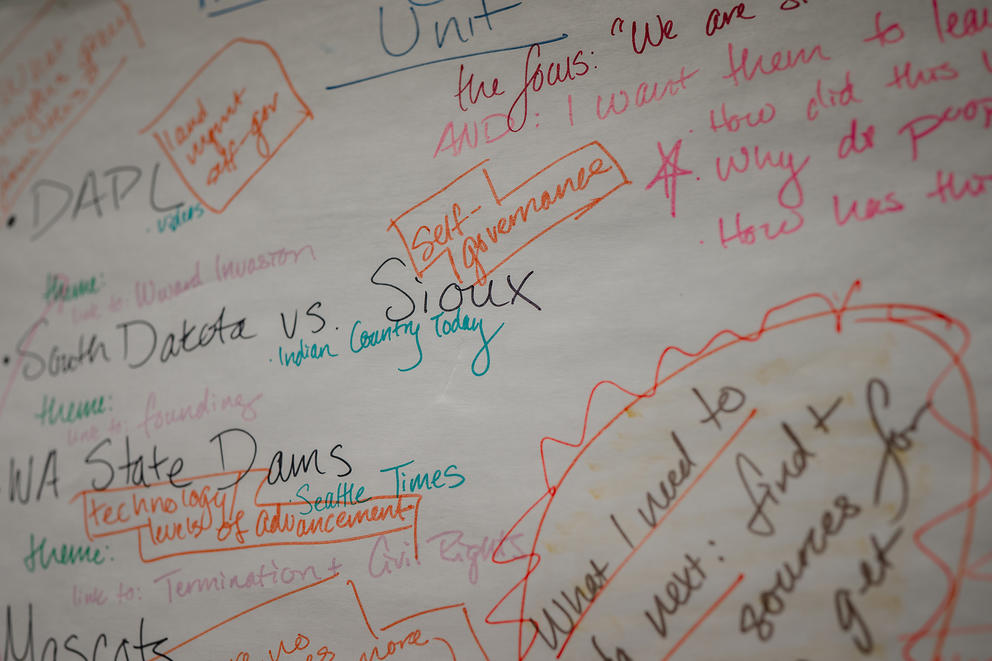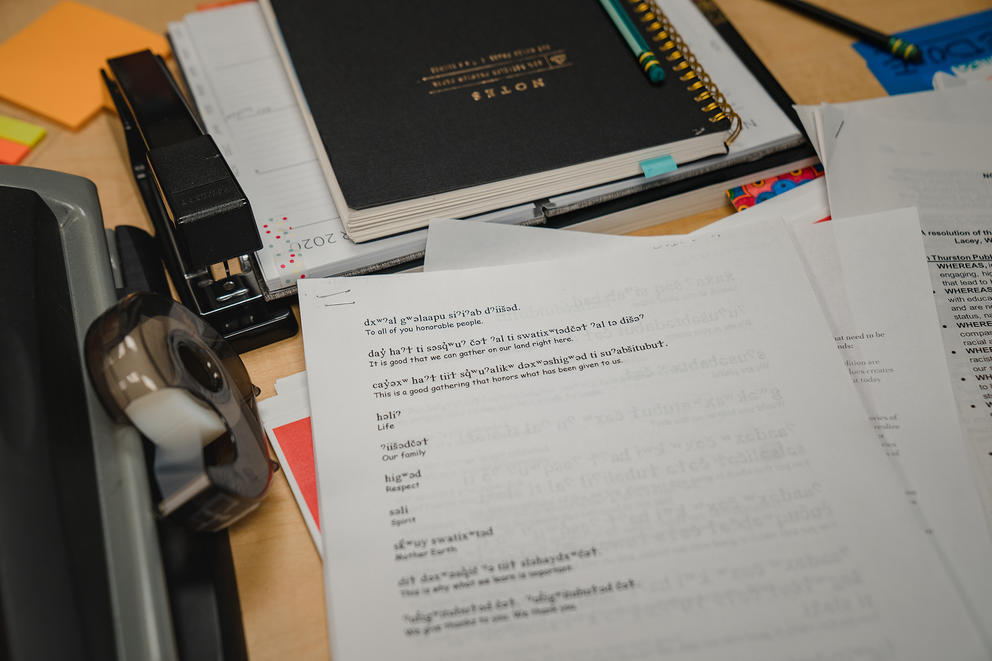Some students answered aloud. Others typed out a response in the classroom’s virtual chat room. As the answers filtered in, she got the answer she expected: Not everyone came into this class knowing the history of Native treaties. Some didn’t even know they existed.
This is the second year River Ridge has offered a U.S. history class through Native perspectives. While many teachers might start their lessons with stories from a couple of hundred years in the past, McCartan started her PowerPoint with a conversation about the Dakota Access Pipeline protests. Mass protests only started in 2016, but as she told her students, there’s a history behind the protesters' concerns — and part of that boils down to understanding tribal treaties.
She knows that some students may have heard this history before, especially since the class is a mixture of Native and non-Native learners. But for many, regardless of background, it’s their first time talking about these topics in a classroom setting.
Then, she asked: At this point, a month and a half into the class, how many of their friends knew as much or more about treaties than they did?
The students answered that question quickly: Practically none.
McCartan says the reality is that Native history education, especially with lessons including modern history, is hard to come by.
“You have to seek it out a lot of the time,” she says. “That’s not how it should be.”
That problem starts young. A 2015 study found that 87% of state history standards in the country don’t teach Native American history after 1900, and 27 states don’t even mention Native Americans in their K-12 curriculum. Generally, studies find that the narratives surrounding Native people paint them as “historical.” Jerad Koepp (Wukchumni)*, the school district’s Native student program specialist, says this sets up a world where Native people are invisible.
“If you don’t recognize Native people and don’t think they’re still around, it’s easy to dehumanize them,” he says.
Some of this is changing. In 2015, Washington passed the “Since Time Immemorial” (STI) curriculum requirement as a first step towards better educating students about Native history. The law applies to all schools, requiring that they teach a tribally developed curriculum. The STI curriculum the state offers includes information about everything from treaties to tribal sovereignty. It also requires that school districts build relationships with tribal governments, which means that they must consult tribes as they begin to incorporate Native perspectives in their lessons.
Progress toward putting the law in action has been slow. Schools that lack previous relationships with tribes in their area are starting from scratch. The STI curriculum itself has existed since 2005, and River Ridge’s school district trained its teachers in it when it was still just optional.
But until the curriculum became a requirement in 2015, many school districts didn’t engage with it. McCartan says she had never heard of STI before getting hired at River Ridge in 2016.
Nisqually Councilmember Willie Frank III remembers what the North Thurston School District was like in the years before McCartan’s class came into existence. The tribe did have a relationship with schools in the area, especially since the Nisqually reservation is adjacent to the district and many kids living on the reservation attended them. Even so, Frank says that it was more of a “check the box” relationship for a while.
But in the last couple of years, Frank says there’s been a huge change, and McCartan’s class is one symptom of it. The class still teaches U.S. history, but it’s all through a Native lens — which is completely novel for her students.
By the October lesson, her students had covered more Native history in a couple of months than they’d ever covered in school before.
Just think, McCartan told them, about what happens to the people who weren’t taught any of this, who may have grown up and taken important positions in government: “How much worse do you think that ignorance of treaties gets?”
River Ridge High School history teacher Alison McCartan works in her classroom on Thursday, Nov. 12, 2020, at the high school in Lacey, Wash. River Ridge High School is one of the first in the state to create a U.S. history class that is taught through Native perspectives.(Jovelle Tamayo for Crosscut)
Facing history
Frank says school proximity to a tribal reservation rarely delivers results: If students are not Native, they’re often oblivious to basic parts of Native communities’ experience. They often don’t understand fishing rights, or why tribes own casinos or smoke shops or even that the Nisqually Indian Tribe has its own sovereign government.
Changing that starts with teaching the teachers. The day he got the call last year from his niece’s school principal at a North Thurston high school, alleging she’d punched a fellow student, reminds Frank that this history has real-world consequences.
As the principal explained the situation, Frank guessed the rest of the story. His niece often came home with stories about comments other students would make about her being Native — one kid had been calling her names like “casino Indian” for a while. This time, she retaliated. Frank remembers bristling when the principal brought up her proposed punishment.
“This kid’s been harassing my niece for the past couple months, and you haven’t done anything about it,” he says, recounting what he said on the call. “If that’s the case, I’d like to come in and talk to you guys because you have a bigger issue at North Thurston than a girl punching a boy.”
The two met soon after to talk it out, and the principal eventually apologized. The other student was told to keep his distance from Frank’s niece. He says instances like that happen all the time.
“It always frustrates the hell out of me that, when our people stand up for themselves, the bullies end up playing the victim,” he says. “That’s not just happening in North Thurston or in the schools, that happens in life — when we stand up for ourselves, we look like we’re the ones bullying people.”
Public schools have rarely been a comfortable place for Native kids: Boarding schools in the 1900s sought to assimilate Native kids into Euro-American culture by prohibiting them from engaging in cultural practices or speaking their languages.
Bill Kallappa II (Makah), a member of Washington’s Board of Education, says that this history has impacts even today. Now, about 90% of Native students in the United States attend public schools where tribal influence has historically been suppressed. Studies show that many are actively hostile environments for Native kids, like those with “Native” mascots.
“A lot of that negative history and historical trauma still exists,” says Kallappa. He knows tribes that, since he was in elementary school, have been actively trying to build relationships with schools. He says their success rate has been more “miss than hit.”
And even for tribes that haven't reached out to schools, he says, “There’s a lot of mistrust still between tribes and districts, so we need to work to continue to improve those relationships.”
With fellow Nisqually Councilmember Hanford McCloud, Frank is focused on changing that. The two have visited schools and educated teachers around the state about Native history and culture for years. McCloud says they saw some progress, and schools liked their visits, but making these lessons a permanent fixture in their lesson plans was a different story.
“Why isn’t there a place for this in this classroom?” McCloud says he would ask. “Why do we have to fight so hard to get our information in there?”
It was the same for River Ridge. McCloud and Frank made visits there before without seeing permanent changes to curriculum. That changed after Frank met Mike Smith, the school’s previous assistant principal, when Frank dropped off his niece for her first day at River Ridge in 2018, which was a school she previously attended.
Smith had analyzed the numbers and knew that Native students typically have low graduation rates, but he knew that the problem went deeper. The large majority of principals in schools are white men over 40, he says, and many, including himself, were trained in “colorblind” standards of addressing these issues.
“Part of the issue is school leaders, as a whole, we were not trained in how to do this,” he says. “We had zero training on Indigenous rights, Indigenous sovereignty.”

Smith approached Frank that day, initially asking how he could make Native students more comfortable at the school — and from there, those conversations grew. Nisqually and school representatives started meeting regularly. All throughout 2019, the school invited tribal leaders to give presentations on campus and, in turn, teachers were invited to the Nisqually Reservation for workshops that would teach them about the tribe’s contemporary history and culture.
“As a person who serves Native students, I could see an immediate improvement in the increase of Native visibility,” says Koepp, the district’s Native student program specialist. “Teachers became a lot more aware and attentive.”
After that, Koepp says, he and school administrators began thinking bigger: In 2019, they first celebrated “Billy Frank Jr. Day” as an official school holiday to honor the Nisqually activist. Nisqually flags are now raised alongside the American flag at each school in the district, accompanied by an acknowledgement that the area is historically Native land.

And at River Ridge, this led to conversations about new classes. The U.S. history through Native perspectives class is now in its second year, and a literature class taught through the same lens was added this year.
“These classes aren’t electives,” Koepp says. “These are actual history and English credits, so our district is giving credit to all this work.”
Koepp remembers first flying the Nisqually flag at the school district office last January, which he got to raise himself. He says it was surreal.
“In my family, there are a good several generations where it was really important to be quiet about being Native, because it was dangerous,” he says. “So many people like me, people before me, have worked and struggled so hard for this level of recognition — [so] even as I was doing it, I couldn’t believe it was happening.”
History teacher Alison McCartan’s curriculum planning notes on her whiteboard at River Ridge High School in Lacey, Wash., photographed on Thursday, Nov. 12, 2020. River Ridge High School is one of the first in the state to create a U.S. history class that is taught through Native perspectives. (Jovelle Tamayo for Crosscut)
Evolving classes throughout WA
Jamie Valadez (Lower Elwha Klallam) has taught Klallam language classes at Port Angeles High School since the ’90s. She says the school has had a steady relationship with her tribe ever since. The partnership came fairly easily, she says, especially since Native students are the largest nonwhite racial group in the school.
In 2018, buoyed by the passage of the STI curriculum requirement, she began teaching two new classes: U.S. history through a Native lens, and a Native studies class that surveys the history of tribes within Washington. Like River Ridge, she says the change was made easier by nature of the school’s steady relationship with her tribe. Still, her classes are the first exposure to extensive Native history for many of her students.
“It’s very new to them,” she says. “I try to survey the kids, and most of them have not had too much exposure, whether they’re Native or non-Native.”
In other parts of Washington, schools are implementing the STI curriculum requirement in other ways. The Samish Indian Nation is working with the Anacortes School District to roll out the requirement. Denise Crowe, education program manager with the Samish, describes the relationship between the tribe and district as a “fresh start” compared with what it was before.
“There are a number of districts and tribes that are further along with this work,” she says, especially those close to tribes with reservations.
From the beginning, the Samish were at a disadvantage. The Samish Indian Nation was mistakenly omitted from a Bureau of Indian Affairs’ list of federally recognized tribes in 1969. The tribe didn’t regain recognition until 1996. Only since then has it been able to acquire land and restore its treaty rights, delaying progress toward any partnerships with schools as a result.
“As Samish has rebuilt since 1996, there’s been a growing understanding and sense of Samish history and presence here in the community,” Crowe says. Bringing the tribe’s history and culture to students from elementary to high school, she says, would ensure that for future generations.
Valadez says she hopes to see the same in Port Angeles. Tribes are major employers on the Olympic Peninsula, and she says most adults they hire have to be educated on basic Native history they should have learned earlier. “They shouldn’t have to wait until high school,” she says.
A resource on the Lushootseed language, used by the Nisqually people, on the desk of history teacher Alison McCartan, photographed on Thursday, Nov. 12, 2020, at River Ridge High School in Lacey, Wash. River Ridge High School is one of the first in the state to create a U.S. history class that is taught through Native perspectives. (Jovelle Tamayo for Crosscut)
‘We’re here’
Kallappa, the Washington Board of Education member, doubts much work in implementing the STI curriculum requirement is getting done in districts without tribal relationships. He says that if schools are required to implement Native history, but the workforce in charge of that is largely white and uneducated about it, then those people need training.
“Right now there is no standard for our administrators to have any sort of background or training in ethnic studies or cultural sensitivity,” he says. “It’s never been at the forefront.”
Frank and Kallappa, along with others who’ve developed River Ridge’s relationship with the Nisqually, are working on legislation to address this gap. Their proposal seeks to create a standard for cultural training among school administrators, including training for other communities of color that aren’t Native. Kallappa says they’re working to get the proposal included in the state’s next legislative session.
What he wants most, he says, is for schools to face their pasts and begin healing the hurt they’ve inflicted. That includes teaching Native history, but also doing justice by serving all students of color.
“We’re not going to get a place of healing unless we confront all these bad things together, and change what we know hasn’t worked in the past,” he says. “It can’t just be the Black community or just the Native community — it has to be all of us.”
The class that McCartan teaches is one she never had as a kid. She had to research and revamp her entire approach toward teaching when she was readying herself to teach the history class through Native perspectives. Already, she’s seen her students blossom under this different approach.
“It’s been really powerful,” she says. “Some kids who’d initially been less engaged came alive when it was something that touched on their own knowledge.”
Emilio Lopez, 17, is one of her students this year. He says that before this year, most classes made tribes sound “historical and past tense.” It made no sense to Lopez, who is both Chehalis and Nisqually.
He remembers hearing a conversation between his grandma and mother during Canoe Journey last year, where the two discussed the Native-led movement to bring more attention toward missing and murdered Indigenous women. They could never find coverage of it on the news.
Lopez felt that absence, too — so it was an unexpected surprise when his class included the movement as part of class curriculum only a few weeks ago.
“I feel like this class is definitely trying to get people to realize that this is Native land and that we’re not history,” he says. “There are still Native people around today — we’re here.”
*This indicates a person's tribal affiliation.






